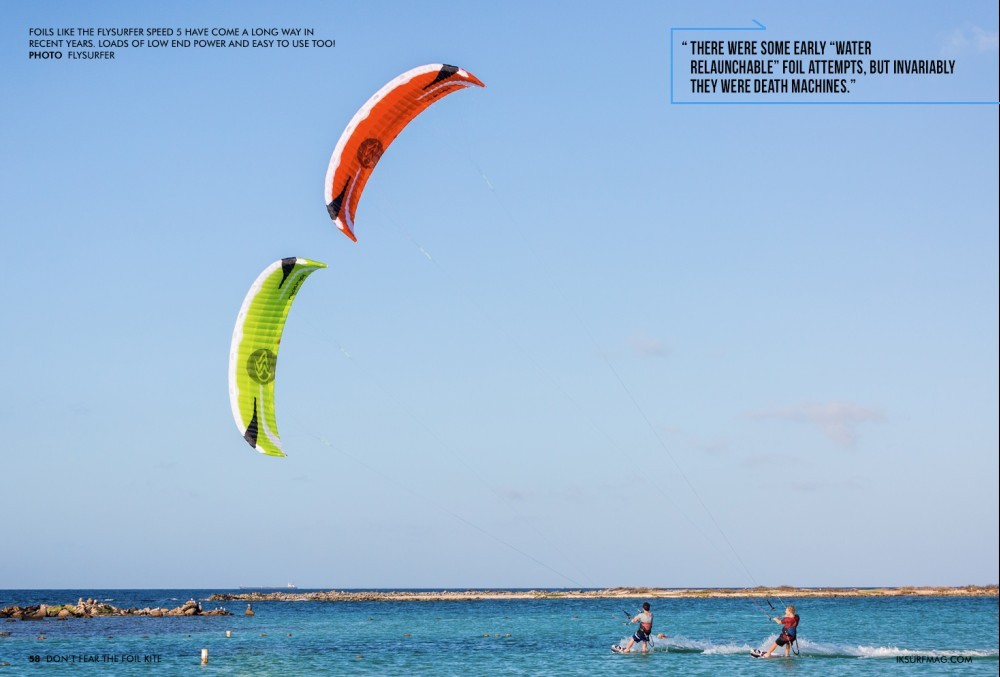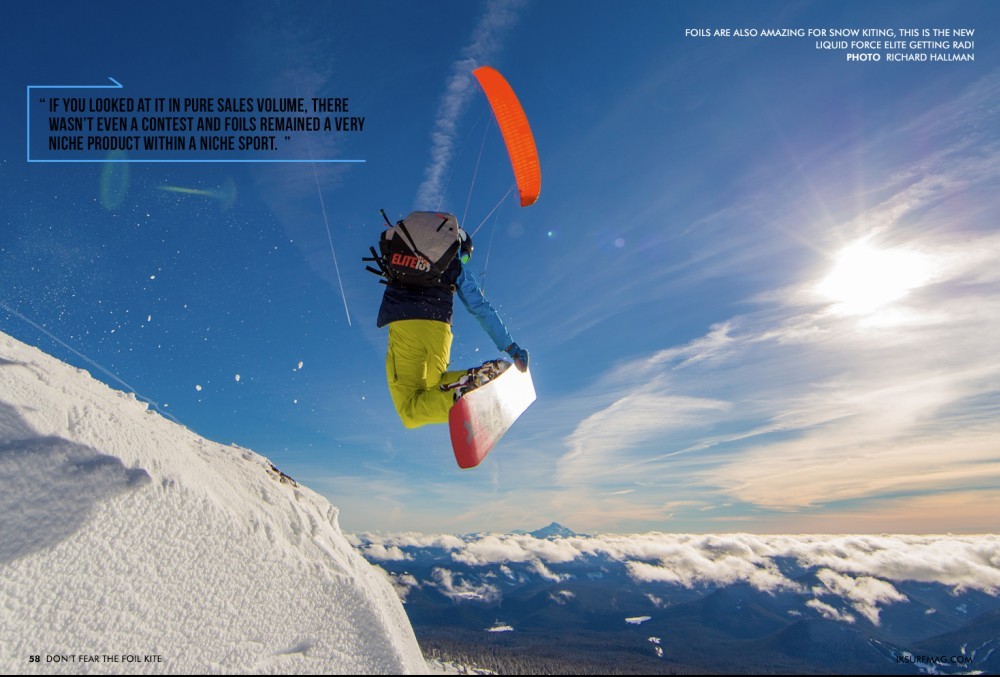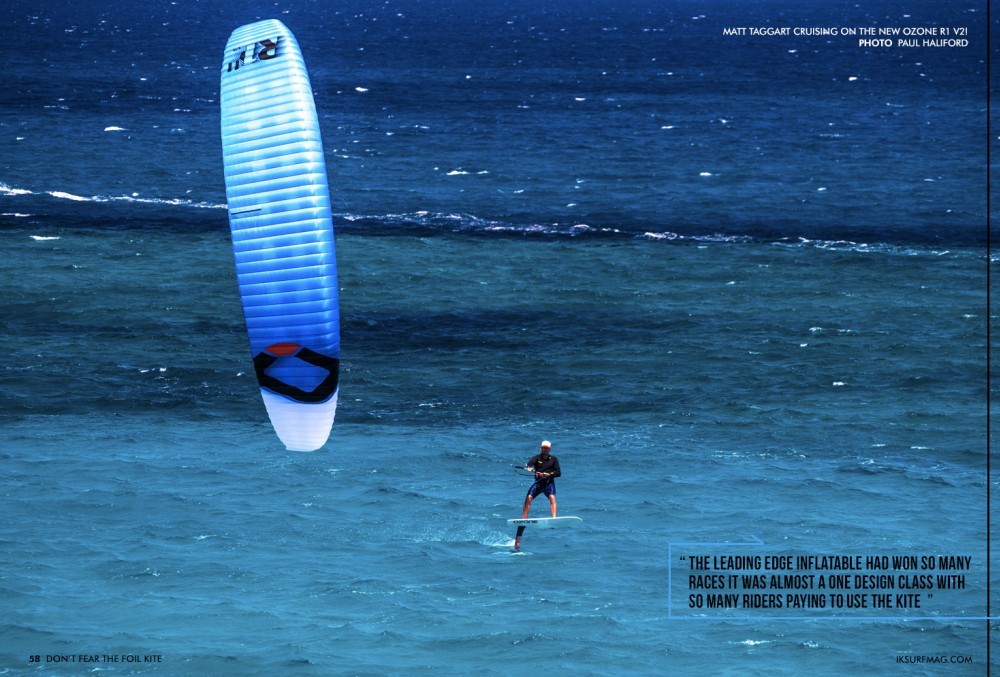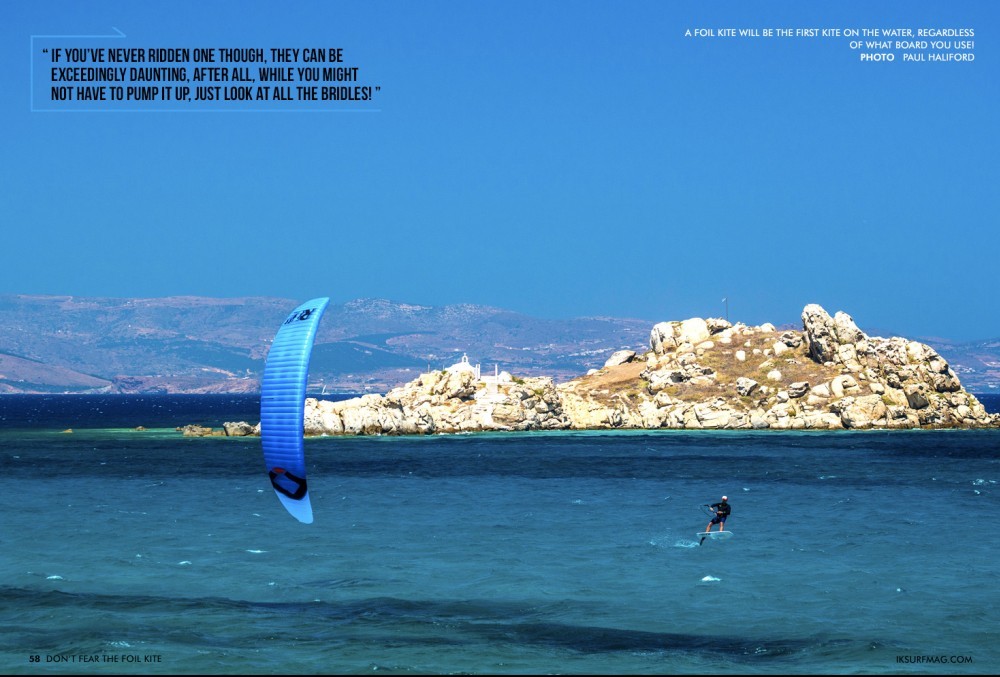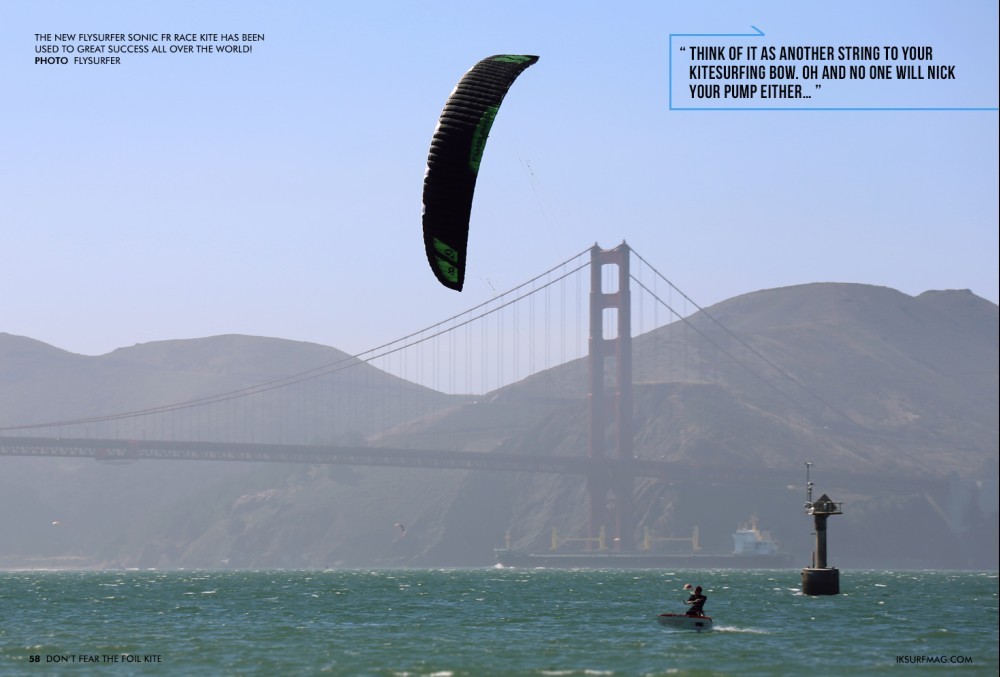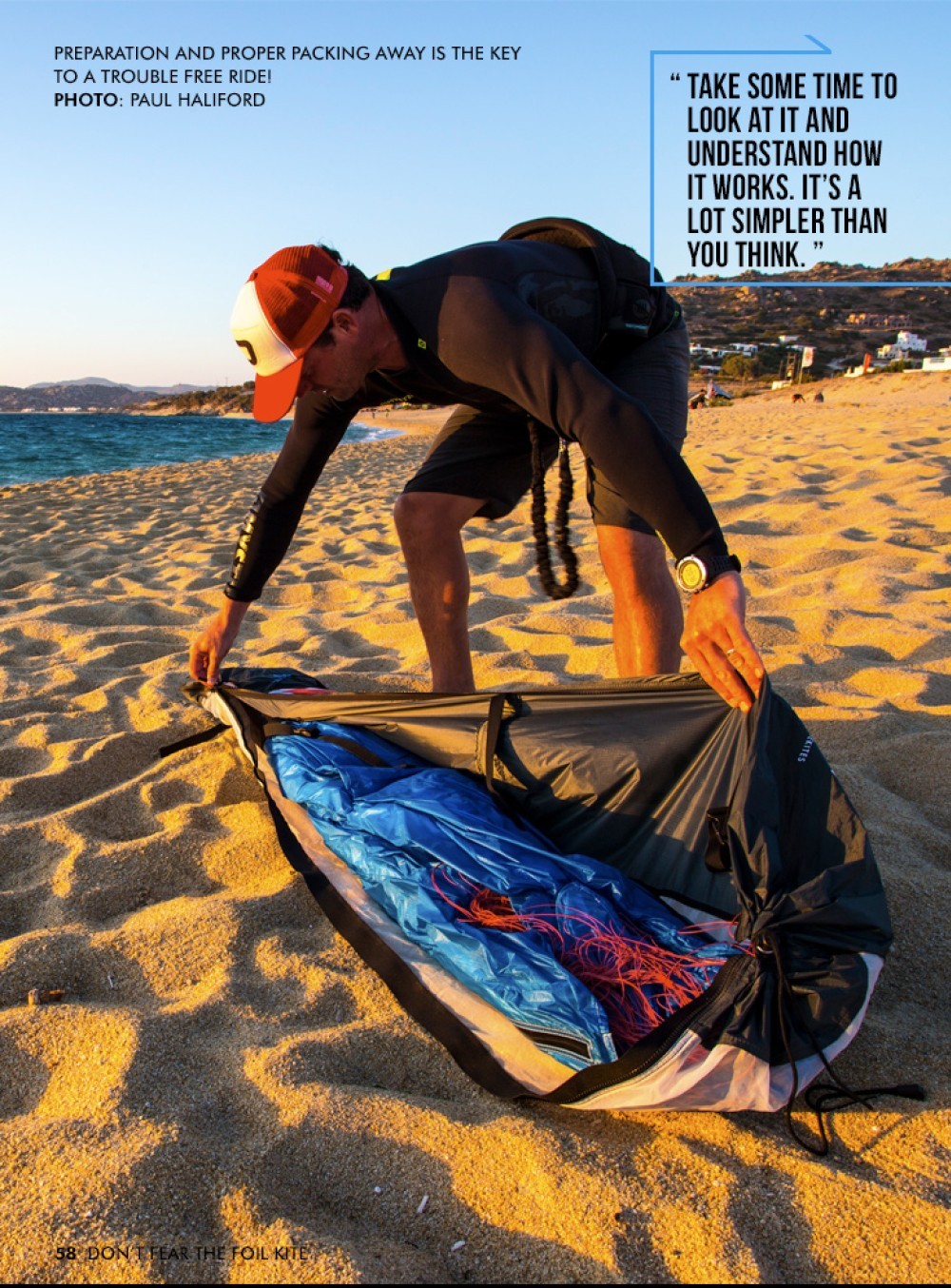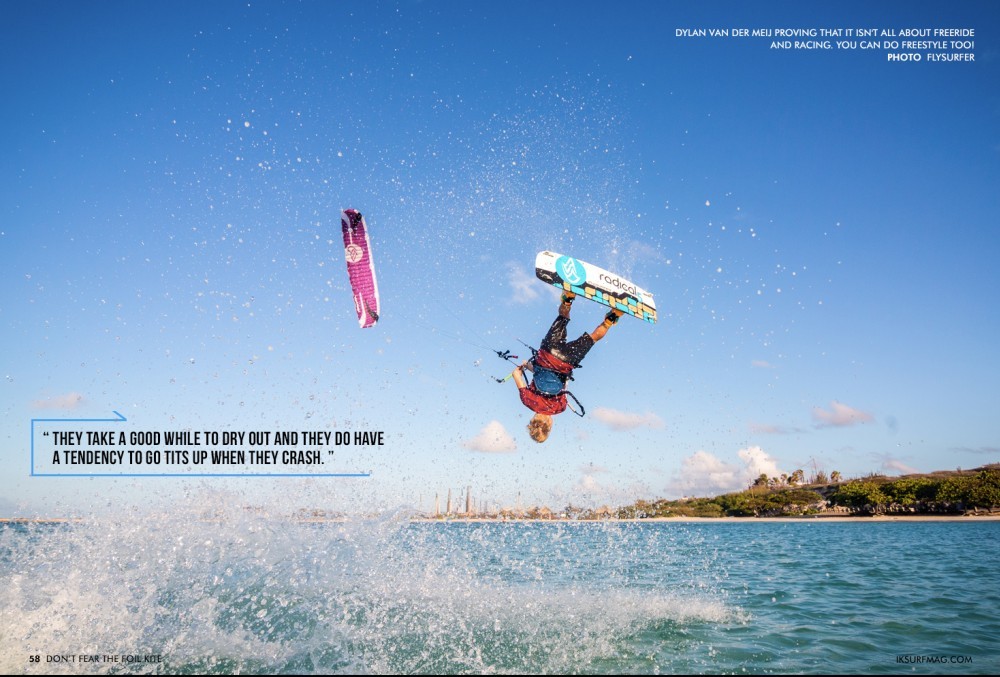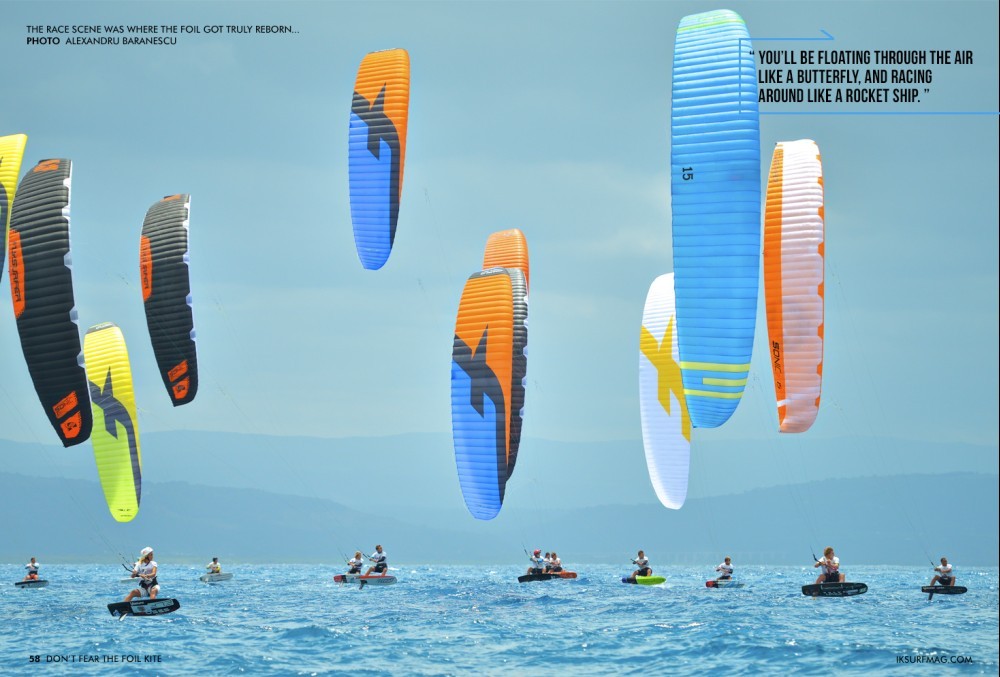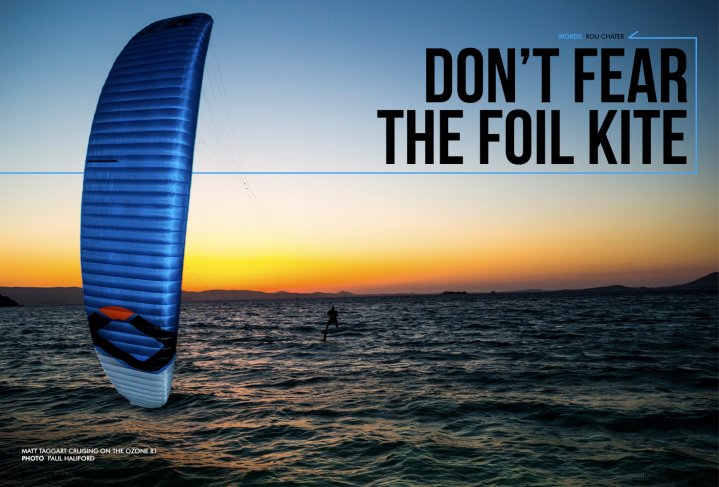
Don't Fear The Foil Kite
Issue 58 / Tue 9th Aug, 2016
Rou Chater looks at the rise of the foil kite in our sport and why you should embrace this new style of kite, not just for racing, but to increase your time on the water and to make you a better all round kitesurfer…
Rou Chater takes a look at the rise of the foil kite in kitesurfing, and why they should be on your radar, even if you aren’t into racing. Foil kites have enjoyed a huge resurgence within our sport recently and with good reason. A few of the leading brands have got on board and started offering options, but are they right for you and should you be considering trying one?
Foil kites have been around for longer than most of us, at the very birth of our sport there was a choice between foil kites and single skin kites with battens, yep think of stunt kites, and you are pretty much on point. Leading Edge Inflatables in those very early days still hadn’t taken hold and certainly weren’t readily available.
When Bruno Legainoux and the Wipika brand brought the first Leading Edge Inflatable kite to market in the late 90’s it had one distinct advantage over the foils. It could be relaunched off the water. That was arguably its only distinguishing feature when held up against it’s more advanced foil siblings.
Kites like the Flexifoil Blade had enjoyed years of development and tweaking; foil kites first became popular in the 1970’s after all. By the time kitesurfing arrived the foil kites of the time were fast and boosted huge floaty airs. It didn’t take a rocket scientist to point out which one was more aerodynamic compared to a LEI; that was plainly apparent. However, there was no relaunching for foil kites in those days. There were some early “water relaunchable” foil attempts, but invariably they were death machines.
The choice then was simple, have a kite that performed and boosted and went upwind, or have a kite that relaunched. Fortunately, the whole relaunching idea was deemed important enough for Leading Edge Inflatables to get the lions share of the development budget. It wasn’t long before brands like Naish and Wipika were cracking the formula to making these inflatable kites work.
The writing was on the wall for the foil kite, why would you ride something that you had to swim in once you crashed it? Flysurfer were one of the first brands to crack a water relaunchable foil. Peter Lynn also had a few offerings on the table. However by the early 2000’s the marketing drive of the bigger brands had cemented the dominance of LEI’s within our sport.
Die-hard riders such as Chris Calthrop would cling on to their Blade kites from Flexifoil, even as all the others around them switched. While Chris might have been scorned at the time for not getting on the program, he might just be having the last laugh now. For a middle period in our sport, it was only really Flysurfer and Peter Lynn that kept pursuing the dream of a relaunchable foil, with increasing success in terms of performance too.
Flysurfer’s Speed kite had a lot of fans around the world, especially in the larger sizes. Around this time though the advantages and disadvantages between the two were stark. Foils you could launch and land on your own, inflatables needed a buddy to launch and land them (this is all pre-bow style and hybrid kites of course). However the performance and relaunch of the LEI’s seemed leaps ahead of these closed cell foil designs, plus the simplicity of a 4-line c kite versus a foil kite with many bridles kept the LEI’s in front. If you looked at it in pure sales volume, there wasn’t even a contest and foils remained a very niche product within a niche sport.
Perhaps a trick that Peter Lynn and Flysurfer missed was making something that was high performance. Instead, they concentrated on user friendliness; this resulted on their kites never getting the biggest jumps, or winning all the races. By the late 2000’s kites like the Ozone Edge and North Dyno were high-performance LEI’s that were winning races, boosting the biggest airs and sitting pretty at the top of the pile.
Then something happened. In 2012 a small group of racers started coming to race events on foil kites made by the Russian kite company Elf. Founded in 2003 Elf had been making foil kites for snowkiting and the Joker kite just so happened to be incredibly efficient and powerful in the light winds that Formula races were often held in. It wasn’t until 2013 however that some of the better racers started using the kites, with devastating efficiency.
In 2014, Ozone launched the Chrono, a closed cell water relaunchable foil kite, in response to losing out on the racing scene to Elf. Previously the Ozone Edge had been the kite to use when racing, the Leading Edge Inflatable had won so many races it was almost a one design class with so many riders paying to use the kite as it was that good.
Obviously, Ozone didn’t want to lose the upper hand they had had, and their paragliding background made them a natural choice for developing a foil kite. The Chrono hit the race scene with a vengeance and by the end of 2014 with limited numbers of Joker’s and not enough Chrono’s to keep up with demand the riders stuck on LEI’s felt like they were getting left behind. The situation got so bad that the International Kitesurfing Association debated banning the use of foil kites at the end of 2014!
The foil kite had arrived, and for racers, it was the only piece of kit to have. F-One joined the game with the Diablo, and now Liquid Force has brought out the Elite. However, if you read the marketing blurb these kites aren’t just for racing, they are perfect for freeriding too. Their natural habitat of light winds are a place we often find ourselves in as riders, so should you be considering adding one to your quiver even if you have no intention of racing?
Many of us fear change, it’s a natural human condition, some of us don’t like learning or being beginners, it was tough enough the first time round, so why would we do it all again? Sometimes, however, there are developments in our sport that our worth stepping out of your comfort zone for, hydro foiling for one! You might go back to being a complete beginner for a bit, but the rewards are endless!
As a kite tester, I have dabbled with foils over the years. I’ve ridden the numerous offerings from Flysurfer and Peter Lynn, as well as some of the more modern designs. If you’ve never ridden one though, they can be exceedingly daunting, after all, while you might not have to pump it up, just look at all the bridles! Compared to the simple 4 line bridle set up most of us are used to, a foil bridle can seem like a bad day at a pasta restaurant.
Some of these kites are exceedingly high maintenance too, in an effort to win races bridles need regular tuning and they use lightweight materials that need care and attention. That alone can be off-putting enough, especially for someone like me! These days there are more and more foil kites designed purely for the freerider like you and me. These aren’t the thoroughbred race machines that want to punish your mistakes; these are easier to fly with a better, more mannered temperament.
They can relaunch off the water, they will get you out in winds your previously thought were not kiteable, and they’ll have you boosting some of the biggest, floatiest jumps you have ever done. There are rewards to be had with foil kites; you just need to get over the irrational fear.
If you are a competent kiter, with good kite skills looking for some improved low-end performance, this is where you want to be. If you are hydrofoiling and want the ultimate light wind weapon, you need to apply here, and with some basic knowledge, you can build your confidence until you are as happy with a foil kite as you are with fact LEI, think of it as another string to your kitesurfing bow. Oh and no one will nick your pump either…
Don’t fear the bridle
The bridle is probably the single most off-putting thing about foil kites. It looks like a total birds nest at the best of times! However, it is, in actual fact, relatively straightforward when you approach it logically. And if you pack your kite away properly each time you could be on the water faster than you would be pumping up an 18m LEI. It just takes a bit of practice and experience.
The bridle usually runs in rows of three or four along the length of the kite; there will be a pulley system in between the front and rear lines. You should be able to pick up these pigtails and shake and stretch any tangles out of the bridle, especially if you leave your bar attached, or packed the kite away properly. Once you hold the bridle taught you can see where each line goes, take some time to look at it and understand how it works. It’s a lot simpler than you think.
Preparation Is Everything
If you set your kite up correctly and pack it down properly, you’ll spend a lot more time flying it and a lot less time swearing at it on the beach…
Foils Need Inflating
Whatever anyone tells you, foil kites need inflating; you can pre-inflate your foil by holding it up into the wind allowing the cells to fill. Launching a pre-inflated foil is far easier than trying to fly what is effectively a bunch of material and string… Ensure you keep constant back line pressure on the kite after you first launch it, this will help to keep the kite steady while it pressurises.
Don’t Crash It
When we learned to kite way back in the day, one of the most popular questions we asked other kiters, aside from “how do you go upwind?” Was “how do you relaunch a kite?” The answer was always “don’t crash it”. I see a big difference in the kite handling skills of people who learned in the early 2000’s compared to those who have learned since the invention of bow style kites in 2005. Old school kiters wipe out and keep the kite in the air as much as possible, because we have it in built into our system that while LEI’s were designed to relaunch, they were pretty terrible at it.
It was easier not to crash it than to relaunch it. The same goes for foils, yes they can be relaunched, but they don’t like getting wet, they take a good while to dry out and they do have a tendency to go tits up when they crash. If you do crash it, you can reverse launch it by pulling on the rear lines if it is nose down, or pull on the front lines if it is nose up. A foil kite will water relaunch in far less wind than an LEI kite.
Practice makes perfect
These kites fly differently to LEI’s so spending more time underneath them will increase your skill set and muscle memory as to how they fly. Take the time to practice launching, relaunching and landing as much as possible. In light winds they are really easy to self-land by just pulling on the rear lines, reversing the kite out of the sky. These are all skills that may be new to you in your kitesurfing career; by embracing them you will make yourself a better all round kiter.
Enjoy It!
We wouldn’t do it if it wasn’t fun! With some basic practice you’ll start to feel as at home on a foil as you do an LEI. You’ll be riding before absolutely everyone else at the beach, you’ll be floating through the air like a butterfly, and racing around like a rocket ship.
Foil kites might seem intimidating, but they shouldn’t be, they aren’t for everyone, but until you’ve tried it you won’t know what you are missing out on!
Videos
By Rou Chater
Rou has been kiting since the sports inception and has been working as an editor and tester for magazines since 2004. He started IKSURFMAG with his brother in 2006 and has tested hundreds of different kites and travelled all over the world to kitesurf. He's a walking encyclopedia of all things kite and is just as passionate about the sport today as he was when he first started!




